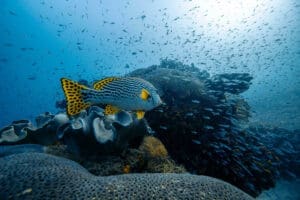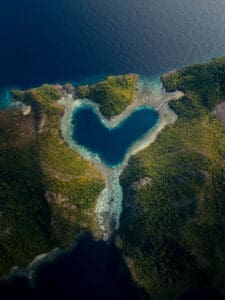Imagine diving into the crystal-clear waters of Triton Bay, Indonesia, surrounded by thriving coral reefs and colorful marine life, when suddenly, a gentle giant emerges from the depths—a whale shark, the largest fish in the ocean. These awe-inspiring creatures, known for their gentle nature and striking spotted patterns, are one of Triton Bay’s most popular attractions.
Hidden in remote West Papua, Triton Bay is part of the Bird’s Head Seascape, one of the world’s most biodiverse marine ecosystems. The pristine waters, rich with plankton, attract whale sharks year-round, offering divers and snorkelers the rare opportunity to swim alongside these majestic creatures in their natural habitat.
In this comprehensive guide, we’ll explore everything you need to know about whale sharks in Triton Bay, including the best times to visit, diving tips, conservation efforts, and how to have an ethical and unforgettable encounter.
What Are Whale Sharks?
🐋 The Largest Fish in the Ocean
Yes, Whale Sharks are fish (Just very big ones). Despite their immense size, reaching lengths of up to 18 meters (59 feet), whale sharks or Rhincodon typus, are completely harmless to humans.
They are filter feeders, meaning they consume plankton, small fish, and krill by swimming with their massive mouths wide open.
Distinctive Features of Whale Sharks
✔ White spots & stripes – Whale sharks have a distinctive pattern of white spots and stripes on a dark blue-grey background. Each whale shark has a unique pattern of spots, similar to human fingerprints, which can be used for identification.
✔ Body Shape – They have a cylindrical body that tapers towards the rear, with a wide, flat head that constitutes a significant portion of their body size. Their snout is rounded, and they have five large gill slits on either side of their head.
✔ Big Mouths – Whale Sharks have REALLY big mouths, which can be over 5 feet wide. It is located at the front of their head, unlike most sharks where the mouth is on the underside. They use this wide mouth to filter feed, sucking in large amounts of water to capture plankton and small fish.
✔ Small Teeth – But a big mouth doesn’t mean big teeth. Whale sharks have around 3,000 tiny teeth, each less than 6 mm long, which are used in their filter-feeding process.
✔ Sensory Organs – They possess a lateral line system for detecting vibrations and movements in water, aiding in navigation and finding food. Their small eyes are equipped with a tapetum lucidum, enhancing their vision in low light conditions.
✔ Skin – The skin of whale sharks is covered with tiny, tooth-like scales called denticles, which provide a hydrodynamic surface. Beneath the skin is a layer of fatty tissue that can be 10-15 cm thick, aiding in buoyancy and insulation.
These features make whale sharks not only the largest fish but also one of the most uniquely adapted species in the ocean.
🌍 Where Are They Found?
Whale sharks are highly migratory, often found in tropical and warm temperate waters worldwide. However, Triton Bay stands out as a premier location for whale shark encounters, thanks to its nutrient-rich waters and traditional fishing platforms (bagans), where whale sharks gather to feed.
Why Triton Bay is a Whale Shark Hotspot
Part of the Coral Triangle
Triton Bay is part of the Bird’s Head Seascape, which includes Raja Ampat and Cenderawasih Bay—collectively known as the epicenter of marine biodiversity. The bay is home to over 900 species of reef fish and 450 species of coral, making it an incredible ecosystem that supports large marine life, including whale sharks.
Bagans – The Key to Whale Shark Sightings
One of the most fascinating aspects of whale shark behavior in Triton Bay is their interaction with bagans, or floating fishing platforms. Fishermen use these structures to catch small fish like anchovies, and the whale sharks, drawn by the easy meal, frequently gather beneath them.
Conservation and Research Efforts
The area has attracted attention from conservationists and researchers due to the whale shark encounters. Conservation International runs a whale shark ID and monitoring program in Kaimana, which helps in understanding and protecting these species
Best Time to See Whale Sharks in Triton Bay
✔ Whale sharks can be seen year-round, but sightings are most reliable from October to April.
✔ This period aligns with the West Monsoon season, when plankton blooms are more abundant, attracting more marine life.
✔ Ocean conditions are generally calmer, making it the best time for diving and snorkeling.
Diving & Snorkeling with Whale Sharks in Triton Bay
How to Swim with Whale Sharks
✔ Join a guided diving or snorkeling trip – Reputable operators ensure ethical encounters.
✔ Respect their space – Maintain a minimum distance of 3 meters (10 feet).
✔ No touching! EVER! – Whale sharks have a delicate mucus layer that protects them from infections.
✔ Use reef-safe sunscreen – Prevents harmful chemicals from entering the water.
✔ Stay calm & move slowly – Sudden movements can startle the sharks.
Best Dive Sites for Whale Sharks
✔ Iris Strait – The heart of Triton Bay’s marine life, often visited by whale sharks.
✔ Little Komodo – Known for its soft coral gardens and rich fish life.
✔ The Aquarium – A hotspot for underwater photography with vibrant marine biodiversity.
✔ Bagan Sites – Floating fishing platforms where whale sharks gather to feed.
Conservation Efforts for Whale Sharks in Triton Bay
🐋 Protecting the Gentle Giants
Whale sharks are classified as Endangered by the IUCN, mainly due to bycatch, illegal fishing, and habitat destruction. Triton Bay is part of the Kaimana Marine Protected Area, where conservation organizations and local communities work together to protect whale sharks and their habitat.
✔ Tagging & Monitoring Programs – Researchers track migration patterns to aid conservation.
✔ Community-Based Tourism – Encourages locals to protect whale sharks instead of exploiting them.
✔ Sustainable Diving Practices – Ensuring encounters do not disrupt natural behaviors.
💡 How You Can Help:
- Book eco-friendly tours that follow ethical guidelines.
- Follow marine conservation rules while diving.
- Support local businesses that contribute to conservation efforts.
FAQs About Whale Sharks in Triton Bay
When is the best time to see whale sharks in Triton Bay?
The best season is October to April, when plankton blooms attract more whale sharks.
Can I snorkel with whale sharks in Triton Bay?
Yes! Snorkeling is a fantastic way to experience whale sharks without diving experience.
How do I get to Triton Bay for a whale shark tour?
✔ Fly to Kaimana Airport (KNG) via Jakarta, Bali, or Sorong.
✔ Take a boat transfer (2 hours) to Triton Bay.
✔ Book a liveaboard yacht charter for the ultimate experience.
Are whale sharks dangerous?
No. Whale sharks are gentle and non-aggressive. However, always respect their space.
How does tourism benefit local communities?
Eco-tourism helps fund conservation efforts, provide jobs, and promote sustainable fishing practices.
What gear should I bring for a whale shark dive?
✔ Mask, snorkel & fins
✔ Reef-safe sunscreen
✔ Underwater camera
✔ Wetsuit for comfort
Experience Whale Sharks in Triton Bay with Boatique Charters
A luxury liveaboard or private yacht charter is the best way to explore Triton Bay and encounter whale sharks in comfort and style. Our bespoke diving expeditions ensure ethical, unforgettable encounters with whale sharks, vibrant coral reefs, and breathtaking landscapes.
🚢 Book your exclusive whale shark diving adventure today!






